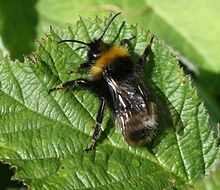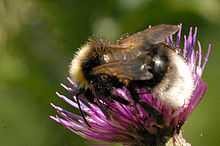Bombus sylvestris
| Bombus sylvestris | |
|---|---|
 | |
| Bombus sylvestris (male) | |
 | |
| Bombus sylvestris, Belgian High Ardennes | |
| Scientific classification | |
| Kingdom: | Animalia |
| Phylum: | Arthropoda |
| Class: | Insecta |
| Order: | Hymenoptera |
| Family: | Apidae |
| Genus: | Bombus |
| Subgenus: | (Psithyrus) |
| Species: | B. sylvestris |
| Binomial name | |
| Bombus sylvestris (Lepeletier, 1832)[1] | |
| Synonyms | |
| |
The forest cuckoo bumblebee[3] or four-coloured cuckoo bee,[4] Bombus sylvestris, is a species of cuckoo bumblebee, found in most of Europe and the Russian part of Asia.[5] Its main hosts are Bombus pratorum, Bombus jonellus, and Bombus monticola.[6]
Description
This is a small bumblebee, with the queen having a body length of 15 mm (0.59 in) and the male one of 14 mm (0.55 in).[7] The head is round and the proboscis is short. Its fur is black with a yellow collar and a white tail. Sometimes, the bumblebee can have a few pale hairs on top of the head, the scutellum and on tergite (abdominal segment) 1. The male can sometimes be more or less melanistic, or, very rarely in northern Scotland, have a tail that is yellow instead of white.[6]
Distribution
The forest cuckoo bumblebee is present in most of Europe (including Russian Asia) from the northern half of the Iberian Peninsula, southern Italy, and the Balkans in the south to beyond the Arctic Circle in the north, and from Ireland in the west to easternmost Russia.[5] In Britain, it has a widespread but patchy distribution, the major areas being the south-east, north-eastern England, and east Scotland.[6]
Ecology
The species is a cuckoo bumblebee, that instead of constructing a nest of its own, it usurps nests of other bumblebees. Its major host is Bombus pratorum, but Bombus jonellus and Bombus monticola are also visited.[6]
When patrolling for young queens with which to mate, the males fly in circuits about 1 m above ground, marking objects with pheromones to attract the queens.[7]
The bumblebee often visits thistles and bramble. The queen also feeds on flowers such as sallow, deadnettles, dandelion, bay, horse chestnut, lavender, and others, while the male visits clover, green alkanet, hound's-tongue, knapweed, and many others.[6]
References
- ↑ Bombus sylvestris (Lepeletier, 1832) ITIS Report
- ↑ "Bombus sylvestris (Lepeletier, 1832)". Biolib.cz. Retrieved 3 July 2012.
- ↑ http://www.bumblebee.org/cuckoo.htm
- ↑ http://eol.org/pages/1065163/overview
- ↑ 5.0 5.1 Pierre Rasmont. "Bombus (Psithyrus) sylvestris (Lepeletier, 1832)". Université de Mons. Retrieved 6 January 2013.
- ↑ 6.0 6.1 6.2 6.3 6.4 Benton, Ted (2006). "Chapter 9: The British Species". Bumblebees. London, UK: HarperCollins Publishers. pp. 423–425. ISBN 0007174519.
- ↑ 7.0 7.1 "Cuckoo bumblebees". Bumblebee.org. Retrieved 5 January 2013.